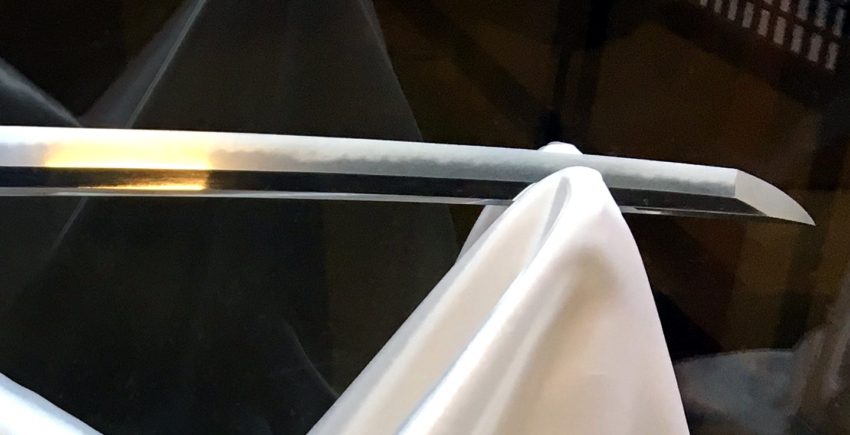Anyone who collects authentic, old Japanese swords should recognize the need for restorations. In many cases, restorations involve complicated repairs that can take quite a bit of money and time. However, the end product of a good Japanese sword restoration process will be a better-looking sword that is worth more than when you first acquired it.
There are, of course, several things to assess about your blade before taking steps to accomplish repairs or replacements. Sometimes, restoring major elements of your sword (such as the blade) may not be an option without causing further, irreparable damage to the integrity of the blade. Care is paramount.
Below you will find a basic guide on how to determine whether or not your sword could use restoration. Several minor aspects of sword restoration might be within the amateur sword collector’s ability, but more often you should seek a professional assessment whenever you are unsure about how to proceed with your Japanese sword.
Several Signs that Your Japanese Sword Might Need Restoration
Older Japanese swords are valued highly, because they represent an earlier period in Japanese and samurai history. They reflect the artistry and nuances of changing eras of Japanese swordsmanship and sword making. This makes them incredibly important to historians and collectors alike.
Over time, however, even the amazing sword making skills of the Japanese cannot stand the test of time without proper care and maintenance. Many swords have been left to rot away by those who don’t understand their value. These swords are the ones most susceptible to damage, such as rust.
Steel
The primary focus for Japanese sword restoration is the beautiful steel blade. After years of improper storage or care, the blade of a sword will rust. Rust damage occurs in varying degrees, but in pretty much all cases it is necessary to send in a sword to a professional sword polisher. They will know the best way to reveal the hidden grace, beauty, and value of your blade.
Handle/Hilt (Tsuka)
Another place prone to damage following years of poor maintenance is the tsukaTSUKA 柄 "handle or hilt" learn more..., or handle. Carefully check the wood core of your sword’s handle and note cracks or shrinkage. Obvious damage to the handle is certainly a cause for concern due to the danger of picking up a sword with a damaged handle.
The Scabbard
Very old scabbards can easily become contaminated with dirt and rust, which can then compromise the blade of the sword. Any indication that the scabbard of your sword is dirty is a sign to immediately get your sword polished and fitted for a storage scabbard, or shirasaya.
Methods of Japanese Sword Restoration
Blade
Japanese sword polishing is an ancient art and should only be attempted by highly-trained professionals who have worked under the guidance of master polishers for many years. Improper polishing methods or amateur quick-fixes can ruin a blade. Although professional polishing will cost you a pretty penny, it is the price to protect your investment and your sword collection.
Scabbard
Shirasaya, or storage scabbards, are particularly handy after a sword has been restored. For the best results, order a custom shirasaya from a reputable seller. Such scabbards are often fitted to your particular blade and improper manufacturing could land you back where you began with a rusty, ill-looking blade.
Miscellaneous Parts
Most professional restoration experts also offer replacements for a wide variety of the fittings traditionally seen on a Japanese sword. These include habaki, where the blade meets the hilt; tsukamaki, the handle wrappings; and more. A lot of restoration methods depend on the type of damage to assess whether the original might be usable or not.
Do-It-Yourself Japanese Sword Restoration
Although more complicated processes of Japanese sword restoration should only be undertaken by trained professionals, there are several aspects that make great DIY projects for the average sword collector.
This pertains to mainly preventative care after professional restoration is complete. Once you have your sword returned in pristine condition, you will need to maintain a vigorous cleaning and oiling schedule. Japanese sword blades are most susceptible to new rusting right after a complete polish. For at least six months, clean and oil the blade every ten days. Proper tools and equipment can easily be acquired online, with detailed instructions.
Sword Restoration for Dummies… Not Highly Recommended
In the case of true Japanese swords, there are not many more things that can be undertaken by a newbie. Reading a few books or posting on an online forum a few times does not give you enough knowledge to polish a Japanese sword’s blade or even to repair or replace many of the other elements. When in doubt it is better to ask the advice of a professional. They can help set up a plan for restoration, including whether or not certain restorations are advisable or even possible.
What NOT To Do
So you just bought a fairly expensive sword, but it doesn’t necessarily look so pretty. You imagined a finely polished, gleaming blade, with a beautifully colored and wrapped handle, and intricate metal fittings. You want to send it in for a full-scale, professional Japanese sword restoration ASAP.
In the end, however, you might want to rethink that choice.
Not all old, authentic Japanese swords can be restored without compromising some aspect of the weapon – be it the value, character, or authenticity. Causing further damage to an already-damaged sword is a possibility when polishing swords that have already been polished too many times. Some restoration processes are simply too difficult or impossible to accomplish, even by the most experienced professionals.
The biggest reason to not restore a Japanese sword is to avoid taking away the character that helps create the mystique of a Japanese blade in the first place. Some flaws, or kizu, are a result of the use of a sword. While traditionally such flaws would be repaired immediately by a samuraiSAMURAI 侍 "warrior serving a lord" learn more... to maintain proper functioning in battle, you might choose to keep some flaws that add to a story related to your blade. In fact, several flaws go so far as to be impossible to repair.
Modern Replicas
Modern replicas are a great way to bypass all of the headaches involved with Japanese sword restoration. Replicas, while not imbued with quite the same mysterious or grand histories as older blades, are much easier to find. When you buy from reputable sellers, you are guaranteed to receive a blade that matches your expectations. Buying authentic Japanese swords is an expensive hobby.
And a tricky one, too! Not everyone is completely honest when it comes to selling rare, expensive weaponry. (Surprising! I know, right?)
Some modern replicas also give you the opportunity to turn your sword collecting hobby into a sword wielding hobby. Many lower-priced replicas are made with varying levels of use intended. You would definitely not dare attempt any kind of amateur martial arts with a blade over 70 years old, now would you? Modern replicas might be your weapon of choice if you’d like to go beyond simply collecting swords.
Of course, the ultimate draw of a Japanese sword might be its alluring past. If you are embarking on a serious collection, you should be prepared for the possibility of investing in a professional Japanese sword restoration.

